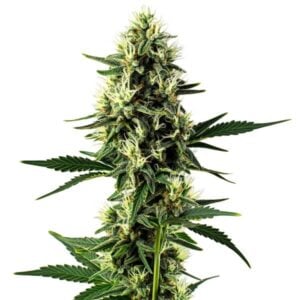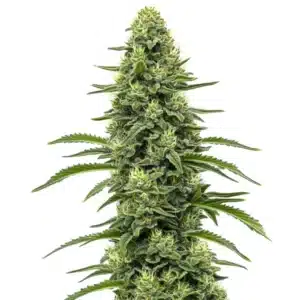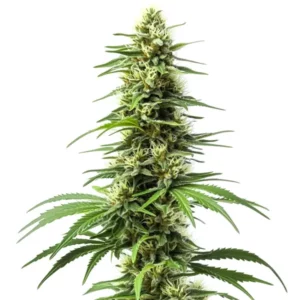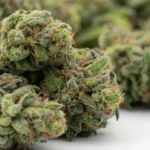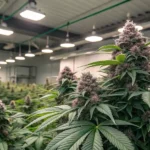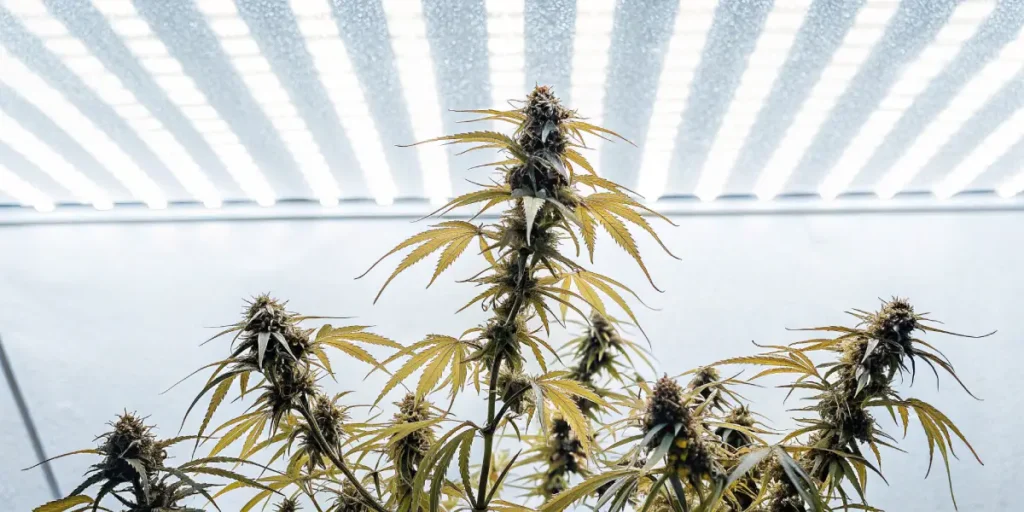
Signs of Poor Transpiration in Cannabis Plants
Transpiration is a vital process for cannabis plants. It’s how they breathe and move nutrients. When this process is off, your plants will let you know. But what are the signs of poor transpiration in cannabis plants? Recognizing these signs early can save your crop and ensure a healthy yield.
Poor transpiration can lead to several visible signs. You might notice yellowing leaves on your cannabis plants. This can be a clear indicator that something is wrong with how your plant is breathing. Leaves play a crucial role in transpiration, and when they start to yellow, it’s a cry for help.
Recommended Strains
Blue Dream
|
|
THC | 17% - 24% (Medium) |
|
|
Type | Feminized |
|
|
Yield | High |
|
|
Phenotype | 50% Indica / 50% Sativa |
GG4
|
|
THC | 27% (High) |
|
|
Type | Feminized |
|
|
Yield | High |
|
|
Phenotype | 40% Indica / 60% Sativa |
Another common sign is curling leaves. When your cannabis leaves curl, it often means that the plant is struggling with transpiration issues. This can happen when the environment is too dry or too wet, affecting the plant’s ability to transport water and nutrients.
Yellowing Leaves in Cannabis Due to Poor Transpiration
Yellowing leaves cannabis poor transpiration is a common issue faced by growers. When the plant cannot efficiently move water from the roots to the leaves, the leaves begin to lose their color. This is often one of the first signs of poor transpiration in cannabis plants.
To address this, ensure that your plants are in a well-ventilated area. Adequate airflow helps in the transpiration process, preventing yellowing. Another tip is to check the humidity levels. High humidity can slow down transpiration, leading to yellowing leaves.
Besides to airflow, it is crucial to maintain proper light exposure. Light plays a significant role in photosynthesis, which is intricately linked to transpiration. Ensuring your plants receive enough light can aid in reducing yellowing leaves cannabis poor transpiration issues.
Also, consider the pH levels of your soil. Imbalanced pH can affect nutrient uptake, exacerbating yellowing leaves. Regularly test and adjust the pH to keep it within the optimal range for cannabis growth. This can help in mitigating signs of poor transpiration in cannabis plants.
Cannabis Curling Leaves: A Sign of Transpiration Problems
Cannabis curling leaves transpiration issues can indicate that your plant is stressed. The leaves curl as the plant tries to reduce its surface area, minimizing water loss. This is a direct response to poor transpiration.
One way to prevent curling leaves is by maintaining consistent temperature and humidity levels. Sudden changes can stress the plant, affecting its transpiration. Consider using a humidifier or dehumidifier to keep conditions stable.
Another preventive measure is to ensure your cannabis plants are protected from pests. Pests can cause physical damage and stress to the plants, leading to curling leaves. Regularly inspect your plants and use natural pest control methods to keep them healthy.
Furthermore, ensure your soil quality is optimal. Poor soil can hinder root development, leading to compromised water and nutrient uptake. Using high-quality soil mixes can support root health and minimize cannabis curling leaves transpiration issues.
Promos & Deals
Wilting Cannabis Plants and Transpiration Issues
When cannabis plant wilting poor transpiration occurs, it is often due to inadequate water movement. Wilting is a sign that the plant is not getting enough water despite the soil being moist. This can happen when transpiration is inefficient.
To combat wilting, check the water quality and soil drainage. Poor drainage can lead to roots sitting in water, affecting transpiration. Using well-draining soil and watering appropriately can keep your plants healthy. Opt for strains like Blue Dream, which performs well with efficient water management.
Besides to well-draining soil, consider the use of mulching to help retain soil moisture. Mulching can prevent the soil from drying out too quickly, supporting steady transpiration. This can be particularly helpful in areas with high temperatures.
Moreover, root health is paramount in preventing wilting. Regularly check for root rot or other diseases, as these can severely impact a plant’s ability to absorb water. Keeping the roots healthy is essential in reducing cannabis plant wilting poor transpiration.
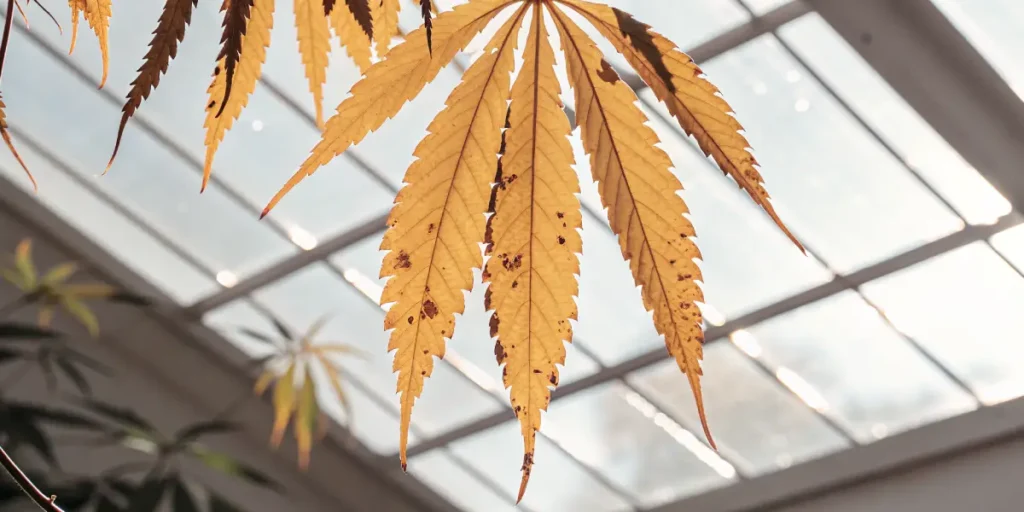
Stunted Growth in Cannabis Due to Poor Transpiration
Stunted growth cannabis poor transpiration is a serious concern for growers. When a plant’s growth is stunted, it could be due to the plant not receiving enough nutrients through transpiration. This affects overall health and yield.
Ensure your plants have access to essential nutrients. Nutrient deficiencies can exacerbate poor transpiration. Regular feeding and using a balanced fertilizer can help. Additionally, monitor your plant’s environmental conditions closely.
To further support growth, ensure the plant has enough space to expand. Overcrowding can limit airflow and light, both crucial for healthy transpiration and growth. Provide adequate spacing between plants to help them thrive.
Additionally, pruning can aid in promoting growth. Removing dead or excess leaves can improve light penetration and airflow, reducing stunted growth cannabis poor transpiration. This also helps the plant focus energy on healthier parts.
Cannabis Plant Brown Edges and Transpiration Problems
Cannabis plant brown edges transpiration problems are another sign of trouble. When leaves develop brown edges, it often indicates that the plant is not transpiring properly. This can be due to salt build-up or inadequate watering practices.
To resolve this, flush your plants regularly to prevent salt build-up. Ensure that your watering routine is consistent and that your plants are not over or under-watered. Proper care can reduce the chances of brown edges developing.
Besides to regular flushing, consider the use of filtered water to prevent mineral accumulation in the soil. Unfiltered water can contribute to salt build-up, exacerbating cannabis plant brown edges transpiration problems.
Furthermore, observe the nutrient mix you use. An imbalance in nutrients can also lead to brown edges. Adjusting your feeding schedule and ensuring a balanced nutrient supply can help in maintaining healthy, vibrant leaves.
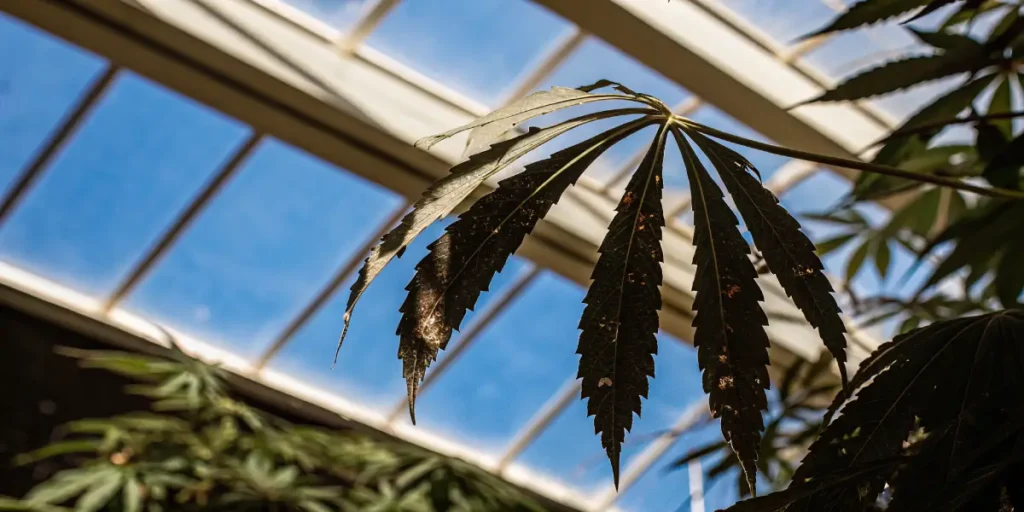
FAQs
What causes yellowing leaves in cannabis plants?
Yellowing leaves in cannabis plants can be caused by several factors, including poor transpiration. When a plant cannot move water and nutrients efficiently, it may show signs of stress, such as yellowing leaves. This is often due to environmental issues like humidity or improper watering.
To prevent yellowing, ensure your plants are in a well-ventilated space with the right humidity levels. Check for nutrient deficiencies and adjust your feeding schedule accordingly to support healthy leaf color.
Additionally, ensure that your plants are not exposed to extreme temperature fluctuations. Drastic temperature changes can stress the plants, leading to yellowing leaves cannabis poor transpiration.
Implementing a regular maintenance routine can also help in early identification of issues. Regularly inspecting plants and adjusting care as needed can prevent and correct yellowing leaves before they become severe.
Why are my cannabis leaves curling?
Curling leaves are often a sign of transpiration issues. When a plant is stressed, it might curl its leaves to reduce the surface area for water loss. This can be due to environmental stress or root problems that affect water uptake.
Maintain consistent temperature and humidity levels to prevent curling. Check your plant’s roots and ensure they are healthy and not waterlogged. Healthy roots support efficient transpiration and reduce leaf curling.
Another factor to consider is the type of fertilizer used. Over-fertilization can lead to nutrient burn, which is another cause of cannabis curling leaves transpiration issues. Adjusting the fertilizer application can alleviate this.
Providing shade during peak sunlight hours can also reduce stress on the plants, preventing curling. Too much direct sunlight can cause excessive transpiration, leading to leaf curl as a protective response.
What should I do if my cannabis plants are wilting?
If your cannabis plants are wilting, it could be a sign of poor transpiration or root issues. First, check the soil moisture and drainage. Overwatering or poor drainage can lead to root problems that affect transpiration.
Ensure your plants are in well-draining soil and are watered appropriately. Adjust your watering schedule based on the plant’s needs and environmental conditions to prevent wilting.
In cases of consistent wilting, consider adjusting the light exposure. Too much or too little light can affect plant health and transpiration efficiency. Balancing light exposure can help reduce cannabis plant wilting poor transpiration.
Regularly monitor the condition of the growing medium. Compacted or old soil can hinder root growth and water uptake, so refreshing or aerating the soil can improve plant vigor and reduce wilting.
How can I improve stunted growth in my cannabis plants?
Stunted growth in cannabis plants can result from poor transpiration. To improve growth, ensure your plants have access to essential nutrients and are not experiencing environmental stress. Regular feeding and maintaining optimal conditions can promote healthy growth.
Choose resilient strains like those from Blimburn Seeds to support robust growth. Monitor your plant’s environment closely and make adjustments as needed to encourage healthy development.
Besides to nutrients and environmental control, training techniques like topping or low-stress training can encourage bushier growth. This can help in overcoming stunted growth cannabis poor transpiration by allowing better light distribution and airflow.
Furthermore, regular soil testing can ensure that the growing medium supports plant growth. Nutrient imbalances can lead to stunted growth, so maintaining soil health is pivotal in encouraging robust plant development.
Why do my cannabis plants have brown edges on their leaves?
Brown edges on cannabis leaves can indicate transpiration problems, often due to salt build-up or inconsistent watering. Flushing your plants regularly and maintaining a consistent watering schedule can help prevent this issue.
Ensure that your plants are not over or under-watered and that the soil drains well. Adjust your care routine based on your plant’s specific needs to maintain healthy, vibrant leaves.
Moreover, evaluate the water source for potential contaminants that may contribute to brown edges. Using clean, pH-balanced water can prevent mineral build-up and improve transpiration efficiency.
Additionally, maintaining a balanced nutrient regimen can prevent cannabis plant brown edges transpiration problems. Overfeeding or uneven nutrient distribution can lead to leaf damage, so regular monitoring and adjustments are beneficial.




